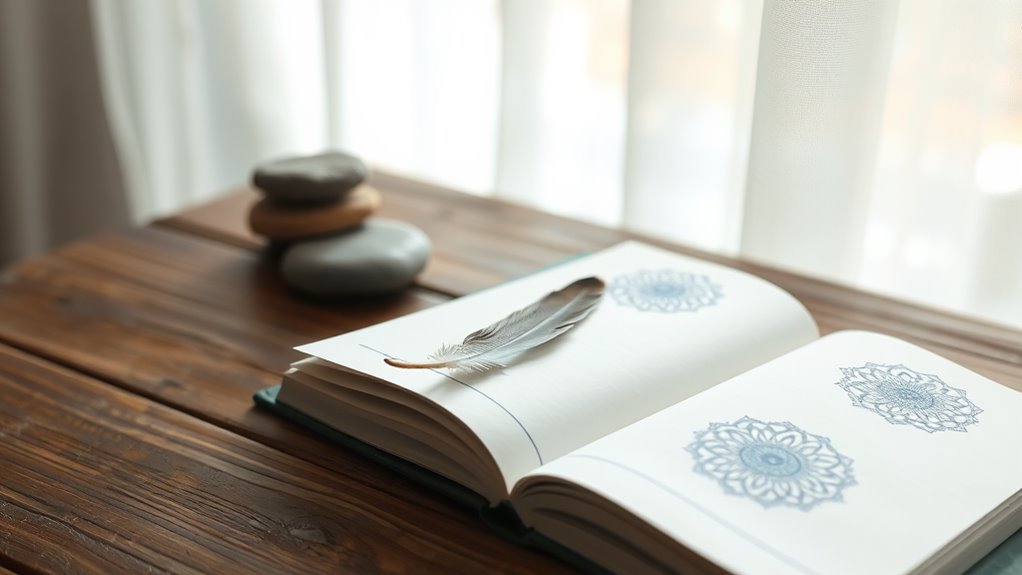
Journaling can be a lifeline for easing anxiety. Start by describing the source of your anxiety to pinpoint triggers. Write a letter to your stressor for an emotional release. Create a “Things to Release List” to identify and confront anxious thoughts. Recall joyful moments to nurture positivity, or pen a letter to your body or past self for healing. Track anxiety patterns through a Morning Thought Diary. List activities that calm you and reflect on anxiety’s impact to gain insights. These prompts empower you to understand and manage your anxiety more effectively, offering tools and guidance to explore further.
Describe Your Anxiety’s Source
Reflect on the specific environments, places, or individuals that awaken these feelings. Recognizing these specific situations can heighten your awareness of anxiety triggers and aid in developing strategies to manage them effectively.
Letter to Your Stressor
Writing a letter to your stressor can be a powerful tool for managing anxiety. This stressor letter lets you identify and express emotions like anger, hurt, or worry, providing an emotional release that’s safe and empowering.
Including practices such as mindful eating can further help in stress management by promoting awareness of food intake and alleviating anxiety-related eating habits. When you acknowledge these feelings by putting pen to paper, you strip them of their intensity, allowing clearer understanding and more effective management of your emotions. The act itself is therapeutic—a liberation from the weight of pent-up stress.
Pour your thoughts onto the page and watch as your fears and concerns crystallize into something manageable. As your stressor letter unfolds, you’ll find clarity in the chaos, sorting out what truly troubles you and pinpointing triggers previously camouflaged in the shadows of your mind. Stress serves as a signal to pause and reassess life priorities, helping to realign your focus and actions according to what truly matters.
This process sharpens mental clarity, offering a fresh perspective on complex issues that felt overwhelming. With each word, gain self-awareness and achieve relief.
This journey onto paper helps distance yourself from negativity, channeling energy towards constructive paths. Ultimately, you gain control over emotions and embrace self-compassion.
Things to Release List

Underneath the weight of anxiety lies the power to release. Initiate creating your “Things to Release List” as a method of liberation. Begin by identifying those anxious thoughts tugging at your mind. It’s not always easy, but write down the top five thoughts or fears haunting you. Recognize them to confront them.
Notice the physical sensations that accompany your anxiety, and put them on paper. By naming these fears, you start using potent release techniques.
Next, explore the themes that commonly appear in your anxious thoughts. Are there repeating fears or patterns? See them clearly and pen them down. This is part of letting go; acknowledging your worries sets the stage for releasing them. When you see fear for what it truly is, it begins to lose its hold.
Now, list everything weighing heavily on your heart. Fears, doubts, or worries—this is their moment to be released. By doing so, you’re lighting a path toward freedom. Each item you release represents a step away from the chains of anxiety. Additionally, consider progressive muscle relaxation as a technique that can physically alleviate the tension associated with these thoughts, creating deeper emotional release and clarity.
Recall a Joyful Moment
Amidst a sea of anxious thoughts, recalling a joyful moment offers a solid anchor to more positive experiences. You can transform your emotional state by focusing on joyful memories, allowing emotional reflection to replace anxiety with happiness. Here’s how you can harness these memories to ease stress:
- Choose a specific moment: Think of a joyful memory that stands out. Maybe it was a sunny day in the park with laughter echoing in the air. Paint the picture vividly in your mind.
- Dive into the details: Describe the emotions you felt during this time. Was it a sense of freedom, joy, or peace? Capture the elements that made the moment significant, like the warmth of the sun or the sound of a familiar laugh.
- Reflect on its impact: Consider how this moment contributed to your sense of gratitude. Acknowledge the people who were present and their importance in shaping the experience.
A positive interaction during exercise, similar to recalling joyful moments, can boost mood and foster a positive emotional state.
Body or Past Self Letter

In moments of anxiety, writing a letter to your body or past self allows you to express gratitude and seek forgiveness.
This practice helps you embrace self-compassion and encourages personal growth by acknowledging past struggles without judgment.
Express Gratitude and Forgiveness
Start your journey toward alleviating anxiety by focusing on gratitude and forgiveness, two powerful tools for emotional healing.
Begin with grateful reflections: picture a fulfilling time and the activities and surroundings that contributed to your joy. Identify people involved and recurring themes across such fulfilling moments. This practice helps shift your focus from anxiety to positivity, allowing you to appreciate the richness of life.
In your daily journaling routine, use prompts like “Today, I’m grateful for…” to anchor emotional wellbeing and stress reduction.
Forgiveness also plays an essential role in your emotional liberation. Initiate a forgiveness journey by writing letters to your body or past self.
In a letter to your body, express appreciation for its resilience and acknowledge how it copes with anxiety. Offer comfort and reassurance, marking your path toward acceptance and self-love.
To your past self, offer forgiveness and wisdom learned from past anxieties. Reflect on these experiences and the growth they’ve inspired. Observing the release of resentment reveals the emotional relief and reduced anxiety that come with forgiveness.
- Grateful Reflections: Identify joyous experiences.
- Forgiveness Journey: Write to your body and past self.
- Daily Practice: Incorporate gratitude and forgiveness in journaling.
Encourage Self-Compassion and Growth
Creating a safe and inviting space can greatly enhance your journey toward self-compassion and growth. Begin by transforming your environment into a peaceful haven that welcomes introspection. Consider using self compassion techniques to nurture this exploration. Speak to yourself kindly, as if to a dear friend. Let go of judgment and embrace your humanity.
Reflecting on past challenges can be transformative. Use journaling to process these experiences mindfully, enhancing personal growth strategies. Recognize your emotions honestly, connecting personal pain to the universal human experience. This understanding can foster a deeper sense of empathy, both for yourself and others.
| Self-Compassionate Language | Reflect on Difficult Experiences | Practice Kindness |
|---|---|---|
| Gentle words | Process mindfully | Words of comfort |
| Self-acceptance | Acknowledge pain | Extend empathy |
| Supportive self-talk | Connect to humanity | Celebrate growth |
Challenge negative self-talk by identifying the self-critical voice and replacing it with compassionate narratives. Acknowledge that perfection isn’t necessary for progress. Adjust unrealistic standards for yourself; these modifications can considerably decrease stress and anxiety. Reflect periodically to review your progress and celebrate your resilience. Your journey toward self-compassion and growth begins with each word you write.
Craft Affirmations for Peace
Often, crafting affirmations for peace can be a transformative practice for managing anxiety. They help redirect negative thoughts, fostering a positive mindset and easing anxious rumination. By using affirmation examples tailored to your concerns, you can replace unwanted patterns with uplifting ones.
Affirmations encourage self-motivation and, when used as a daily practice, can greatly enhance your emotional well-being.
Creating effective affirmations involves focusing on positive, present-tense statements. Confirm they’re specific to your concerns and believable to maintain authenticity. Here are three steps to craft empowering affirmations:
- Identify emotional triggers: Tailor affirmations to address specific anxiety-inducing situations.
- Use precise language: Keep affirmations focused and actionable, such as “I am in control of my thoughts.”
- Make them routine: Repeat affirmations regularly, integrating them into your morning or night routine, and track their impact.
Incorporating mindfulness practices into your routine can further enhance the effectiveness of affirmations by fostering a deeper connection to the present moment. To integrate affirmations into your journaling, dedicate a section to write them down. Reflect on their importance and the feelings they evoke.
Anxiety Patterns and Triggers

Understanding your anxiety patterns and triggers is essential for managing your symptoms effectively.
Take some time to recognize what situations or thoughts typically lead to your feelings of anxiety.
Recognizing Anxiety Patterns
Identifying the patterns and triggers of anxiety is essential for managing it effectively. You can gain insight into your anxiety recognition by paying attention to symptoms such as an uneasy feeling or trouble sleeping.
One effective approach is to keep a journal where you record your experiences. As you journal, you’ll start noticing patterns and develop effective coping strategies. Here’s how you can begin your journey towards freedom from anxiety:
- Track Common Symptoms: Note when you feel anxious, if there’s trouble breathing, or if your hands get cold and sweaty. Recognizing these can help you anticipate and manage what’s coming.
- Acknowledge Impact on Life: Reflect on how anxiety interferes with your daily routine. Are there times when avoidance behavior has stopped you from doing something important? Making this recognition allows you to prepare and strategize effectively.
- Understand Cognitive and Behavioral Aspects: Anxiety often includes negative automatic thoughts. By identifying these, you can begin to challenge and change them, paving the way for liberation.
Identifying Key Triggers
Building on the understanding of anxiety patterns, it’s important to pinpoint the specific triggers causing your anxious feelings. Start by identifying the “elephant in the room”—that primary issue that consistently stirs up your anxiety.
List your top five anxious thoughts to uncover recurring themes. Immerse yourself in your fears, describing them vividly: when do they creep in, and how do they make you feel? Notice the physical manifestations of anxiety in your body and pinpoint the situations or events they’re linked to.
In anxiety management, it’s essential to distinguish between controllable and uncontrollable factors. List what you can influence versus what’s beyond your grasp. Reflect on past events where high anxiety surprisingly led to better outcomes.
Break bigger anxieties into smaller, more manageable parts. Recognize how long worry patterns persist, aiming for liberation through understanding and acceptance.
Analyze your emotional and thought patterns. Explore emotions triggered by certain situations or people, and note the impact of self-talk on your anxiety levels.
Remember instances that brought smiles to your face, and think about why the opposite events trigger anxiety. By addressing these triggers with awareness, you’re empowering yourself with the ultimate tool for anxiety management: knowledge.
Morning Thought Diary
Upon waking, starting your day with a Morning Thought Diary can greatly ease morning anxiety and enhance your overall mental clarity. This practice invites you to embrace freedom by releasing cluttered and anxious thoughts. Immerse yourself in morning reflections using effective journaling techniques, and experience the profound benefits they offer.
- Morning Pages: Begin with three full pages of stream-of-consciousness writing. Let your thoughts flow without the constraints of grammar or editing, much like windshield wipers clearing your mind’s vision. This simple act of recording everything can reduce anxiety and set a positive tone for your day.
- Expressive Writing: Explore your emotions and thoughts without self-judgment. By doing so, you can navigate through challenging feelings and clear mental clutter. Acknowledge fears and vulnerabilities to foster emotional liberation and boost your mental well-being.
- Gratitude Practice: Incorporate gratitude lists into your journaling session. Shifting your focus to positive aspects in life not only enhances happiness but can also improve emotional regulation and mental health.
Engaging in these practices daily creates a supportive environment, keeping your thoughts organized and your mind focused. This prepares you to venture into the day liberated from anxiety’s grasp. Incorporating mindfulness practices such as breathing exercises alongside journaling can enhance emotional awareness and further reduce stress throughout the day.
Activities That Calm List

Amid the whirlwind of anxious thoughts, engaging in calming activities can be your anchor. Imagine the freedom of stepping outside for a walk, feeling the earth solid beneath your feet, and letting nature work its gentle magic.
Physical movement like exercise and yoga not only invigorates you but also dispels the tension that anxiety can weave into your body. A hot bath becomes a sanctuary, each drop helping you shed the day’s stress.
Creative expression is your portal to liberation. Drawing or painting allows you to lay bare your emotions without uttering a word. Use colors to mirror your mood, and see how doodling can distract and soothe.
Try making mandalas—each intricate detail can guide you toward inner calm, away from anxious noise.
Incorporate mindful breathing to ground yourself. Deep breathing exercises can slow the chaos in your mind, while guided meditation helps focus your senses on the here and now.
Through mindfulness journaling, you capture fleeting moments of peace, anchoring them with words. Adjust your daily routine to infuse self-care, affirmations, and gratitude, allowing you to relinquish the grip anxiety might’ve over you.
Embrace this path to liberation.
Anxiety’s Impact on Life
Anxiety can grip your daily life, casting a shadow over simple activities that others might take for granted. Concentration dwindles, decisions become burdensome, and memory plays tricks, all of which disrupt productivity.
Daily routines once smooth and predictable become fraught with challenges. You might find yourself avoiding driving, skipping doctor’s appointments, or sidestepping social situations. It’s a common anxiety coping mechanism but often leads to more stress and unease. Embracing new adventures becomes intimidating, leaving you feeling trapped and stagnant.
Physical health doesn’t escape untouched either. Anxiety manifests through rapid heartbeat, fatigue, and muscle tension, and can even pave the way for more severe issues like heart problems or weakened immunity.
But it’s not just your body that suffers; sleep disturbances can interrupt the rest needed to face daily hurdles with vigor. To thrive, it’s crucial to break free from these chains and embrace liberating strategies.
Relationships, too, aren’t immune. Communication falters, misunderstandings blossom, and social circles shrink. Yet, don’t let anxiety dictate your life.
Evaluate your interactions and set goals for healthier connections. Start by:
- Reconnecting with loved ones.
- Exploring new activities.
- Adopting self-care practices.














